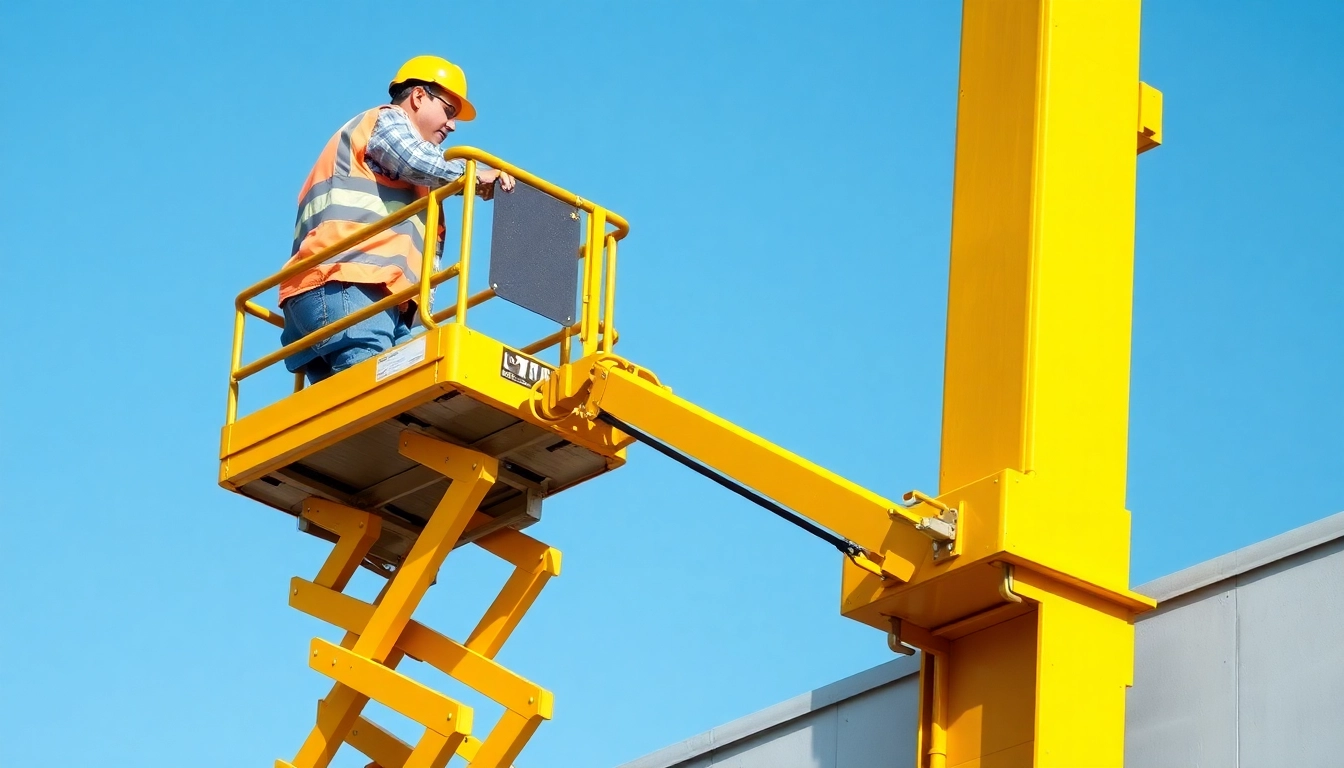Understanding Scissor Lift Rental: Types and Uses
In the construction, maintenance, and industrial sectors, working at height safely and efficiently is paramount. Scissor lifts have become a versatile solution for elevating workers and equipment in a wide variety of projects. These hydraulic or electric powered platforms allow easy access to elevated work areas, reducing the risk associated with traditional scaffolding or ladders. If your project requires safe and reliable access at height, exploring scissor lift rental options can significantly streamline your operations.
Understanding the various types of scissor lifts and their applications is crucial for selecting the right equipment. This guide provides comprehensive insights into the different models, their ideal usage scenarios, cost considerations, safety protocols, and best practices to ensure your project’s success.
Indoor vs. Outdoor Scissor Lifts
Indoor Scissor Lifts
Indoor scissor lifts are specifically designed for confined or controlled environments such as warehouses, manufacturing facilities, and retail settings. They are characterized by their lightweight construction and electric power sources, which eliminate emissions and excessive noise, making them safe for indoor use. Their compact design allows maneuverability in tight spaces, and low ground clearance helps navigate over uneven but smooth surfaces.
Advantages of indoor models include reduced environmental impact, quieter operation, and precision control, making them ideal for tasks like electrical installation, ceiling maintenance, or indoor painting projects. Notably, electric models with narrow chassis sizes are often preferred for precision work where space is limited.
Outdoor Scissor Lifts
When working outdoors, tougher and more resilient equipment is needed. Outdoor scissor lifts are typically powered by diesel or hybrid engines, designed to handle uneven terrain, wind, and adverse weather conditions. These models feature rugged tires, higher ground clearance, and enhanced stability features to prevent tipping or sliding on unstable surfaces.
Outdoor lifts are suited for construction sites, infrastructure maintenance, and large-scale events. They offer extended reach heights and larger platform capacities, supporting workers and tools over larger outdoor areas. When choosing outdoor lifts, durability and safety features are paramount to ensure reliable operation in diverse environmental conditions.
Electric, Diesel, and Hybrid Models Explained
Electric Scissor Lifts
Electric scissor lifts are powered by rechargeable batteries, and they produce zero emissions during operation. Their quiet operation makes them suitable for indoor environments, especially where air quality and noise levels are critical. Recent advancements in battery technology have improved run times and recharge speeds, increasing productivity.
Diesel Scissor Lifts
Diesel-powered models are designed for outdoor use and can handle rough terrains with greater stability. They deliver higher power output, making them suitable for extensive vertical reach and heavy-duty tasks. However, their emissions and noise levels require caution and compliance with environmental and safety regulations, especially in urban or enclosed outdoor projects.
Hybrid Scissor Lifts
Hybrid models combine electric and diesel power sources, offering flexibility and efficiency. They can switch between modes depending on environmental conditions, providing quieter operation indoors and robustness outdoors. Hybrids are increasingly popular for their economic fuel consumption and compliance with evolving emissions standards.
Best Practices for Choosing the Right Lift
Choosing the appropriate scissor lift hinges on careful assessment of project needs, environmental conditions, and operational constraints. Consider the following factors:
- Height requirements: Determine maximum working height for your project to select a lift with sufficient vertical extension.
- Surface type: Indoor smooth floors versus outdoor uneven terrain influence the choice of model and tires.
- Load capacity: Gauge the weight of workers, tools, and materials to ensure safety and stability.
- Space constraints: Narrow or compact lifts are preferable for tight spaces, while larger lifts suit open, expansive areas.
- Power source considerations: Indoor projects favor electric lifts; outdoor projects often require diesel or hybrid options.
- Budget constraints: Balance initial rental costs with operational requirements to optimize expenditure.
Engaging with experienced rental providers can help customize your equipment choice, ensuring safety, efficiency, and compliance with relevant standards.
How to Maximize Safety and Efficiency in Scissor Lift Rental
Safety Guidelines and Operator Training
Operational safety is paramount when using scissor lifts. Properly trained operators are essential to prevent accidents and ensure smooth workflow. Comprehensive training should cover controls, emergency procedures, weight limits, and hazard recognition. Operators should also be familiar with the specific model’s manual and safety features.
Regular safety briefings and updates are recommended, especially when new equipment or team members are introduced. Certification programs recognized by regulatory bodies, such as CITB or OSHA standards, enhance safety compliance and institutional knowledge.
Proper Site Assessment and Preparation
Before deploying a lift, conduct a thorough site inspection. Identify potential hazards like overhead obstructions, uneven surfaces, power lines, and unstable ground. Establish clear exclusion zones and secure the work area to prevent unauthorized access.
Ensure the ground is capable of supporting the lift’s weight, and set up appropriate barriers or warning signage. Adequate lighting and clear communication channels between personnel help coordinate safe operation.
Maintenance and Inspection Routines
Routine inspections are vital for reliable and safe operation. Daily checks should include tire condition, hydraulic fluid levels, battery status (for electric models), safety restraints, and control functions. All findings must be documented, and any defects addressed immediately.
Periodic professional servicing according to manufacturer guidelines ensures longevity and performance. Rental companies often include inspection and maintenance as part of their service packages, ensuring the equipment remains in peak condition throughout the rental period.
Cost Considerations and Rental Planning
Pricing Models and Price Comparison
Rental costs vary based on factors such as lift type, height capacity, duration, and geographic location. Common pricing structures include daily, weekly, and monthly rates, with discounts potentially available for longer-term rentals or bulk agreements.
On average, electric lifts might range from a few hundred pounds per week, while larger diesel models can cost significantly more, depending on capacity and features. It is advisable to obtain multiple quotations and compare included services, such as delivery, setup, and maintenance.
Rental Duration Strategies for Cost Savings
Longer rental periods typically reduce daily or weekly rates. Planning ahead, consolidating multiple tasks into one rental period, and avoiding unnecessary downtime help optimize expenses. Additionally, some providers offer pre-booking discounts or package deals for large projects.
Additional Fees and Insurance Options
Be aware of extra charges such as delivery, setup, training, and damage deposit fees. Insurance coverage is crucial to protect against accidental damage or liability; rental providers often include insurance options or recommend third-party policies. Carefully review contract terms to avoid unforeseen costs.
Implementation Steps for Successful Rental Projects
Assessing Project Requirements
Start with a detailed project plan, specifying the scope, height access needs, timeline, and environmental conditions. Develop a checklist to match equipment specifications with project demands — ensuring safety standards and operational efficiency.
Choosing a Reliable Equipment Supplier
Select reputable rental providers with proven track records, industry accreditations, and positive customer reviews. Verify their maintenance protocols, delivery logistics, availability of staff training, and after-sales support. Building a strong partnership minimizes delays and enhances safety compliance.
Scheduling and Logistics Coordination
Coordinate delivery times to align with project phases, minimizing idle periods and storage complications. Clear communication about site access, setup requirements, and operator availability helps streamline operations. Employ project management tools to monitor equipment use and downtime.
Measuring Success and Maintenance of Rented Scissor Lifts
Performance Tracking and Feedback
Implement performance metrics such as productivity rates, incident reports, and operator feedback to evaluate equipment efficiency. Regular feedback helps identify potential improvements and ensures the lift operates within safe parameters.
Post-Rental Inspection Procedures
Upon project completion, conduct detailed inspections to identify any damages or maintenance issues. Document findings and communicate with the rental provider to address repairs or replacements. Proper inspection protects your organization from liability and helps preserve equipment condition for future use.
Extending Equipment Lifespan and Return Protocols
Adopt best practices for storage, cleaning, and minor maintenance to extend the lifespan of rental equipment. Ensure that all return procedures comply with contractual terms, including timely pickup, residual damage assessments, and final documentation. Efficient handling reduces costs and fosters positive relationships with rental suppliers.








